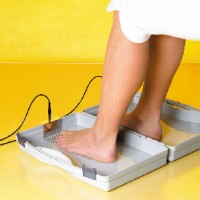Hyperhidrosis treatment
Heavy sweating under the armpits and/or on the hands and feet is very unpleasant and associated with illness. This is why health insurance sometimes covers the costs. There are various treatment modalities such as tap water iontophoresis, botulinum toxin therapy and surgery, in particular axillary curettage. The dermatologist Dr. Urs Büttiker will discuss the various treatment modalities with you beforehand. All treatments are carried out in the dermatology practice Dermatologist Bern Bubenberg. Aspiration or axillary suction curettage is also offered

Tap water iontophoresis
Tap water iontophoresis is used to treat sweating, particularly on the hands and feet. Botulinum toxin therapy is better for the armpits. Treatment is carried out in our practice three times a week for the first three weeks, and treatment must be continued at home at least once or twice a week to maintain the effect. If the distance is long, the device can also be taken home for a trial treatment. Success can be expected in over 90% of patients, after which a certificate from the health insurance company can be used to request a device for use at home. The health insurance company will cover ¾ of the cost of the device.
How it works: The affected areas of the body, such as the hands and feet, are held in two plastic tubs filled with tap water, through which a weak current is passed using electrodes. The strength of the current is regulated individually so that the patient feels a slight tingling sensation.
Botulinum toxin therapy
Botulinum toxin is injected into the sweating areas (usually armpits, but can also be other areas such as hands, feet, forehead, buttocks) using very fine needles. These sweating areas are specially prepared with a solution beforehand.
The treatment is generally painless, especially if an anesthetic cream is applied beforehand (½ hour). The effect can last ½ to 1 year (treatment of hyperhidrosis with botulinum toxin).
Surgery
Axillary suction (curettage) is particularly suitable for this. The sweat glands are gently suctioned out under local anesthesia using 2 punctures and cannulas.
Clearances
- Objective sweat secretion measurement using gravimetric measurement (secretion in mg/min)
- Semiquantitative determination of hyperhidrosis by the iodine strength test according to Minor (staining of the hyperhidrotic area)
Treatment
- Topical therapy with external agents containing aluminum chlorhydroxide
- Iontophoresis (for the treatment of palmoplantar hyperhidrosis (increased sweating of the palms and soles of the feet))
- Medication therapy for generalized hyperhidrosis (in close cooperation with your family doctor and/or other specialists)
- Botulinum toxin injections for the treatment of focal hyperhidrosis and in selected cases of compensatory hyperhidrosis after sympathectomy (surgical treatment of sweating)
- In selected cases, surgical treatment of hyperhidrosis by means of suction currettage
- Blood test to exclude a systemic disease with hyperhidrosis as an accompanying symptom (exclusion of secondary hyperhidrosis)
Summary of hyperhidrosis treatment
Increased sweating (hyperhidrosis) is a ubiquitous problem and often represents a social and professional stigma for affected patients. There are numerous therapeutic options for treating primary hyperhidrosis, which is usually localized axillary (armpits) or palmoplantar (hands and feet) and which are applied in a step-by-step approach. In the case of secondary, usually generalized hyperhidrosis, internal investigations should be carried out to rule out an underlying disease or medication as the cause.
In our consultation hours, we advise patients individually on general measures to combat increased sweating as well as specific therapeutic options. After exhausting topical therapy with aluminum salts, we usually carry out iontophoresis therapy (tap water iontophoresis) for palmoplantar hyperhidrosis. For axillary hyperhidrosis, intracutaneous injections with botulinum toxin A are indicated. Invasive measures are also discussed, including their effectiveness, consequences and possible side effects. Systemic therapies are also evaluated in individual cases. This is done in collaboration with our colleagues in endocrinology.
